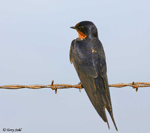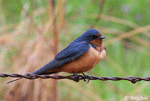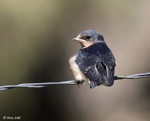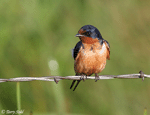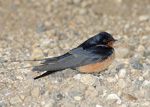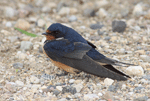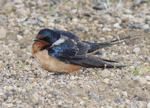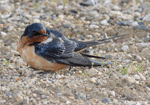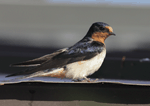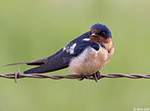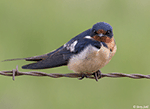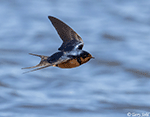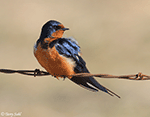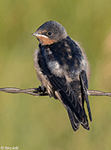| Length: 6.5 to 7.5 inches | Wingspan: 13 inches | Seasonality: Summer |
| ID Keys: Long forked tail, rusty brown throat and forehead, dark blue upperparts, white belly. | ||
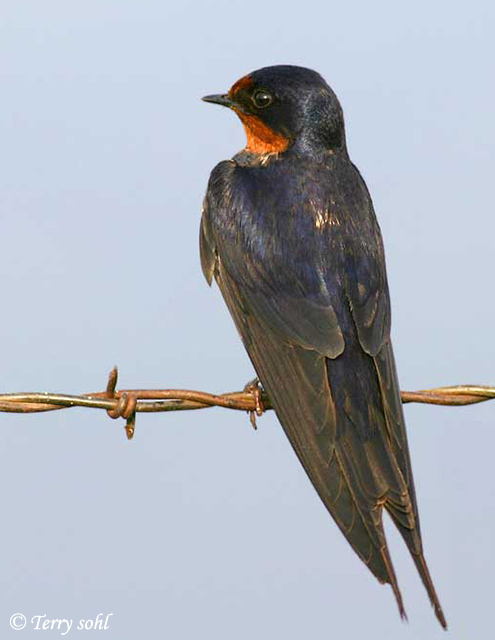 Barn
Swallows are very common summer resident, not only in North America, but in much
of the Eastern Hemisphere as well. They also are found in the Southern
Hemisphere, as that's where many birds spend the North American winter. They are
very comfortable around human activity, and now primarily nests in and around
buildings and bridges. They have probably greatly increased in numbers due
to man-induced land cover change.
Barn
Swallows are very common summer resident, not only in North America, but in much
of the Eastern Hemisphere as well. They also are found in the Southern
Hemisphere, as that's where many birds spend the North American winter. They are
very comfortable around human activity, and now primarily nests in and around
buildings and bridges. They have probably greatly increased in numbers due
to man-induced land cover change.
Habitat:
Barn Swallows are found in a broad variety of semi-open country, including agricultural land, farmsteads, suburban parks and residential areas, and grasslands and shrublands. They nests under/on bridges, barns, houses, culverts, and caves, with the vast majority of nesting now occurring on human structures. They will feed over nearly any type of semi-open terrain.
Diet:
Barn Swallows feed on flying insects almost exclusively, most often going after larger insects if available. In unseasonably cold weather or other periods where insects are extremely sluggish or inactive, they may rarely feed more directly by gleaning insects from the ground or foliage. Only very rarely eats any vegetable matter, and only when in extreme duress and insect prey is unavailable.
Behavior:
Catches and consumes nearly all insects in the air, often flying low over open fields or water bodies. They will also feed on the ground or in vegetation, but only in rare instances of very bad weather.
Nesting:
Late May through Late June. The nest of a Barn Swallow is typically placed in a sheltered location on a man-made structure (even more so than natural locations where available), or against a similar sheltered areas on a rocky slope. The is a cup of mud, sometimes a full, round cup of mud of the nest is placed on top of a gutter, a natural shelf, or other horizontal structure, or a half-cup of mud if constructed against the side of a structure. It is lined with grasses, and finally with feathers. The female lays between 4 and 7 eggs, with both parents helping to incubate them. The young hatch after about 14 days, and fledge from the nest about 20 days after hatching.
Interactive eBird Map:
Click to access an interactive eBird map of Barn Swallow sightings
Song:
The song of a Barn Swallow is a jumble of warbling, twittering notes. Various calls include a churee, often given when alarmed or threatened, or a shorter cheep that may be a contact call.
- Click here to hear the call of a male Barn Swallow1
- Click here to hear alarm calls of a pair of Barn Swallows2
- Click here to hear the bubbling songs of a Barn Swallow3
Migration:
Neotropical migrant. Generally migrates very early in the fall. Barn Swallows are found throughout much of North America and Eurasia in the summer, migrating southward to South America, southern Asia, and Africa in the winter.
Feeders:
As insect eaters, Barn Swallows won't come to feeders for typical food items. However, they will come from ground up egg shells or ground up shellfish shells. It is thought that these items either provide the birds with needed calcium. They may also help the birds in digestion.
Similar Species:
Barn Swallows could potentially be confused with the following species. Note that each of these species lack the deeply forked tail of the Barn Swallow (very noticeable in flight).
- Cliff Swallow - Cliff Swallows have the same deep bluish upperparts and the rust-colored throat of a Barn Swallow. However, Cliff Swallows have a light spot on their forehead (rusty on a Barn Swallow), and have a light-colored rump (same deep blue color on the rump of a Barn Swallow as the rest of its back).
- Purple Martin -Male Purple Martins are easily differentiated from Barn Swallows given their complete, glossy purplish-blue plumage. Female Purple Martin's have a lighter underside that could cause confusion with a Barn Swallow, but they tend to be a dingy gray, as opposed to the creamy-colored or rusty underparts of a Barn Swallow. All plumages of Purple Martin lack the rusty throat of a Barn Swallow.
- Tree Swallow - Tree Swallows have a glossy blue upperparts that could be reminiscent of a Barn Swallow. However, they lack the rusty forehead and throat of a Barn Swallow, lack the forked tail, and have more white underparts rather than the creamy or rusty underparts of a Barn Swallow.
- Violet-green Swallow - Violet Green Swallows do have glossy green and purple upperparts, compared to the bluer upperparts of a Barn Swallow. They lack the rusty throat and forehead of a Barn swallow and are bright white below, rather than creamy or rusty.
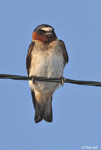 |
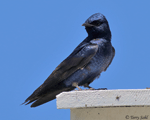 |
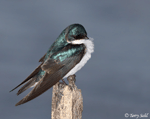 |
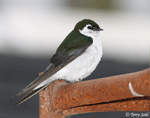 |
| Cliff Swallow | Purple Martin | Tree Swallow | Violet-green Swallow |
Conservation Status:
Systematic surveys have shown modest declines in Barn Swallow populations in both the European and North American parts of their range. However, they are still found across an extremely broad geographic area, and are quite common in many parts of their range. The IUCN considers the Barn Swallow to be a species of "Least Concern".
Further Information:
Photo Information:
August 1st, 2004 -- Near Lake Thompson -- Terry Sohl
Additional Photos:
Click on the image chips or text links below for additional, higher-resolution Barn Swallow photos.
Audio File Credits:
- 1Sue Riffe. Recorded in Morgan City, Colorado on August 8th, 2020. Original recording and information available from xeno-canto.
- 2Simon Elliott. Recorded in York, England on July 3rd, 2020. Original recording and information available from xeno-canto.
- 3Simon Elliott. Recorded in Pembrokeshire, Wales on May 20th, 2016. Original recording and information available from xeno-canto.
| Click on the map below for a higher-resolution view |
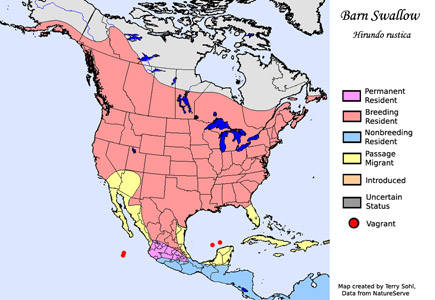 |
| South Dakota Status: Common migrant and summer resident throughout the state. |
Additional Barn Swallow Photos
Click for a higher-resolution version of these photos
